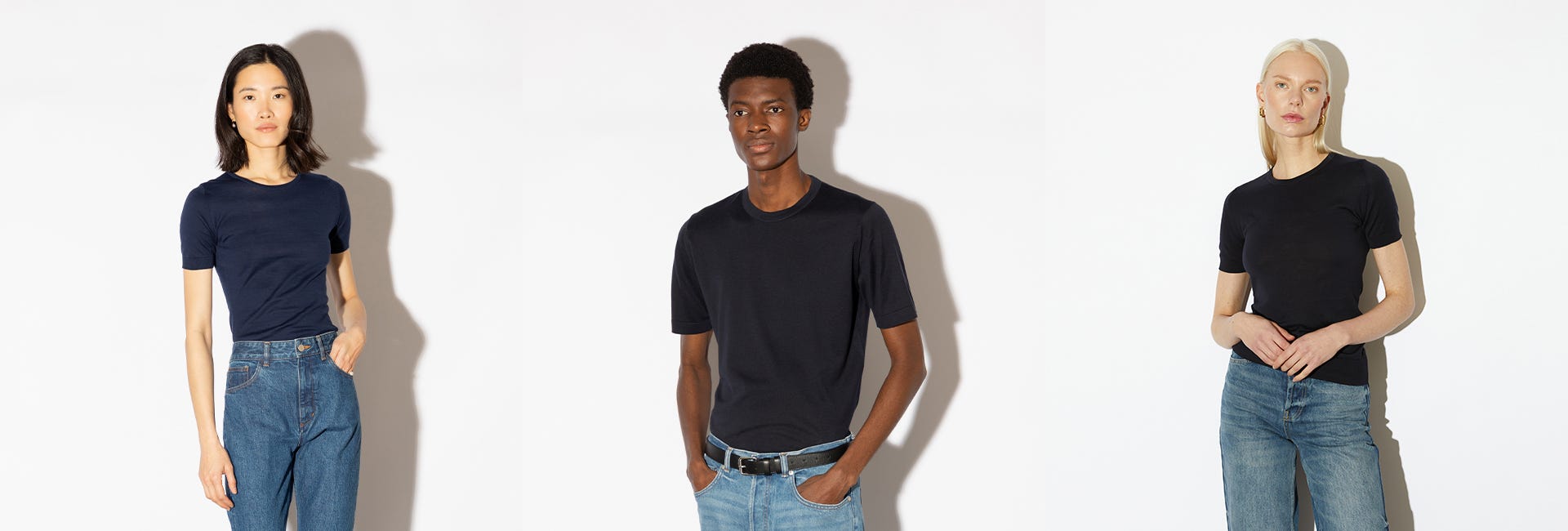The T-shirt is to every wardrobe what salt and pepper are to a kitchen cupboard: a fundamental staple. It’s one that is often overshadowed by more standout ingredients, but which provides a consistent base that’s always in season — and forever appropriate.
In fact, so ubiquitous a fashion item is it today, it’s hard to imagine our wardrobes without them: nowadays, they’re easy, extra layers under shirts or knits but which also hold their own as a standalone top come the warm, summer months. It’s likely we all have double-digit numbers of them in our drawers, in all manner of cotton weights and cuts, from sturdy crew-necked styles to lighter V-necks or polo shirts, some woven with silk or linen.
But it wasn’t always this way. Despite its normcore presence and relative simplicity, the T-shirt has a surprisingly colourful history. Originally, it wasn’t designed to be worn on show at all — it evolved from underwear styles first made popular in the 19th century. (John Smedley built its business on such pieces, creating the first ever fully-fashioned, knitted long johns and cotton undergarments in the 1820s.) For decades, these under layers, mostly worn by men and kids, were just for warmth.
But the T-shirt became its own garment in the early 20th century when the Navy took the concept of a form-fitting layer and turned it into a military uniform. Mixing performance with practicality, the pristine white T-shirt was lightweight but smart — and the sailor’s bib jackets were seamlessly worn atop.
Tops soon replaced button-up shirts as a go-to for men, with the collared polo shirt — imported to the UK from India during British colonial rule in the 1920s, where it was worn by sportsmen — became an off-pitch, smart-casual style for men. John Smedley became known for its knitted cotton versions, which were first made in 1932 and became beloved by Sean Connery.
But it was its collarless, crew-necked counterpart that really cemented the cotton top’s status as an everyday closet hero. Marlon Brando and James Dean changed its trajectory forever. After both actors wore white T-shirts with jeans in the Fifties, the understated tee became a modern symbol of masculinity. In the decades that followed, it became a platform for protest and self-expression — a blank canvas for a statement image or slogan. In the Nineties, women teamed tees with high-rise, stonewashed jeans; others cropped them and paired them with oversized cardigans. Whether minimalism or grunge, there was a tee to match the trend.
Its ability to be reinvented to meet any mood or moment is the main reason the T-shirt has endured. But as with our cupboard stock, today’s staples are not all equal — and a quality tee is one worth investing in, that will last season after season. Ingredients like fit and fibres are key. Organic cotton uses less water and no pesticides during the growing process, making it a more responsible cotton than conventionally grown cloth, while those woven with merino wool benefit from its natural, sweat-wicking threads.
But the cotton that really shines is Sea Island — it’s renowned as being the finest cotton in the world thanks to its extra-long fibre length and super soft feel against the skin. John Smedley has used it since the 1920s, and today, its best-selling tees are all crafted from it — from the round-necked Belden to the roomier Tindall.
And as dress codes remain ever casual, a smart T-shirt is an ideal choice for pairing with relaxed suits for smart-casual weddings or work events. That they’re lower maintenance on the creasing front than a button-up shirt is an even bigger plus. From work to weekend, beach to bar, a good T-shirt is the ultimate buy-now, wear-forever piece — with no sell-by date in sight.







.png)
.png)
.png)
